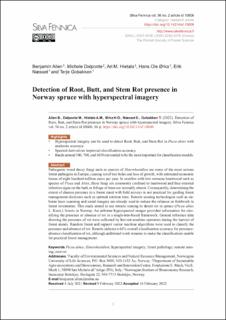| dc.contributor.author | Allen, Benjamin James | |
| dc.contributor.author | Dalponte, Michele | |
| dc.contributor.author | Hietala, Ari Mikko | |
| dc.contributor.author | Ørka, Hans Ole | |
| dc.contributor.author | Næsset, Erik | |
| dc.contributor.author | Gobakken, Terje | |
| dc.date.accessioned | 2022-08-02T18:20:47Z | |
| dc.date.available | 2022-08-02T18:20:47Z | |
| dc.date.created | 2022-05-10T13:07:41Z | |
| dc.date.issued | 2022-02-16 | |
| dc.identifier.citation | Silva Fennica. 2022, 56 (2), . | en_US |
| dc.identifier.issn | 0037-5330 | |
| dc.identifier.uri | https://hdl.handle.net/11250/3009860 | |
| dc.description.abstract | Pathogenic wood decay fungi such as species of Heterobasidion are some of the most serious forest pathogens in Europe, causing rot of tree boles and loss of growth, with estimated economic losses of eight hundred million euros per year. In conifers with low resinous heartwood such as species of Picea and Abies, these fungi are commonly confined to heartwood and thus external infection signs on the bark or foliage of trees are normally absent. Consequently, determining the extent of disease presence in a forest stand with field surveys is not practical for guiding forest management decisions such as optimal rotation time. Remote sensing technologies such as airborne laser scanning and aerial imagery are already used to reduce the reliance on fieldwork in forest inventories. This study aimed to use remote sensing to detect rot in spruce (Picea abies L. Karst.) forests in Norway. An airborne hyperspectral imager provided information for classifying the presence or absence of rot in a single-tree-based framework. Ground reference data showing the presence of rot were collected by harvest machine operators during the harvest of forest stands. Random forest and support vector machine algorithms were used to classify the presence and absence of rot. Results indicate a 64% overall classification accuracy for presence-absence classification of rot, although additional work remains to make the classifications usable for practical forest management. | en_US |
| dc.language.iso | eng | en_US |
| dc.publisher | Finnish Society of Forest Science | en_US |
| dc.rights | Navngivelse-DelPåSammeVilkår 4.0 Internasjonal | * |
| dc.rights.uri | http://creativecommons.org/licenses/by-sa/4.0/deed.no | * |
| dc.title | Detection of Root, Butt, and Stem Rot presence in Norway spruce with hyperspectral imagery | en_US |
| dc.title.alternative | Detection of Root, Butt, and Stem Rot presence in Norway spruce with hyperspectral imagery | en_US |
| dc.type | Peer reviewed | en_US |
| dc.type | Journal article | en_US |
| dc.description.version | publishedVersion | en_US |
| dc.rights.holder | © 2021 by the authors | en_US |
| dc.source.pagenumber | 16 | en_US |
| dc.source.volume | 56 | en_US |
| dc.source.journal | Silva Fennica | en_US |
| dc.source.issue | 2 | en_US |
| dc.identifier.doi | 10.14214/sf.10606 | |
| dc.identifier.cristin | 2023102 | |
| dc.relation.project | Norges forskningsråd: 281140 | en_US |
| dc.source.articlenumber | 10606 | en_US |
| cristin.ispublished | true | |
| cristin.fulltext | original | |
| cristin.qualitycode | 1 | |

